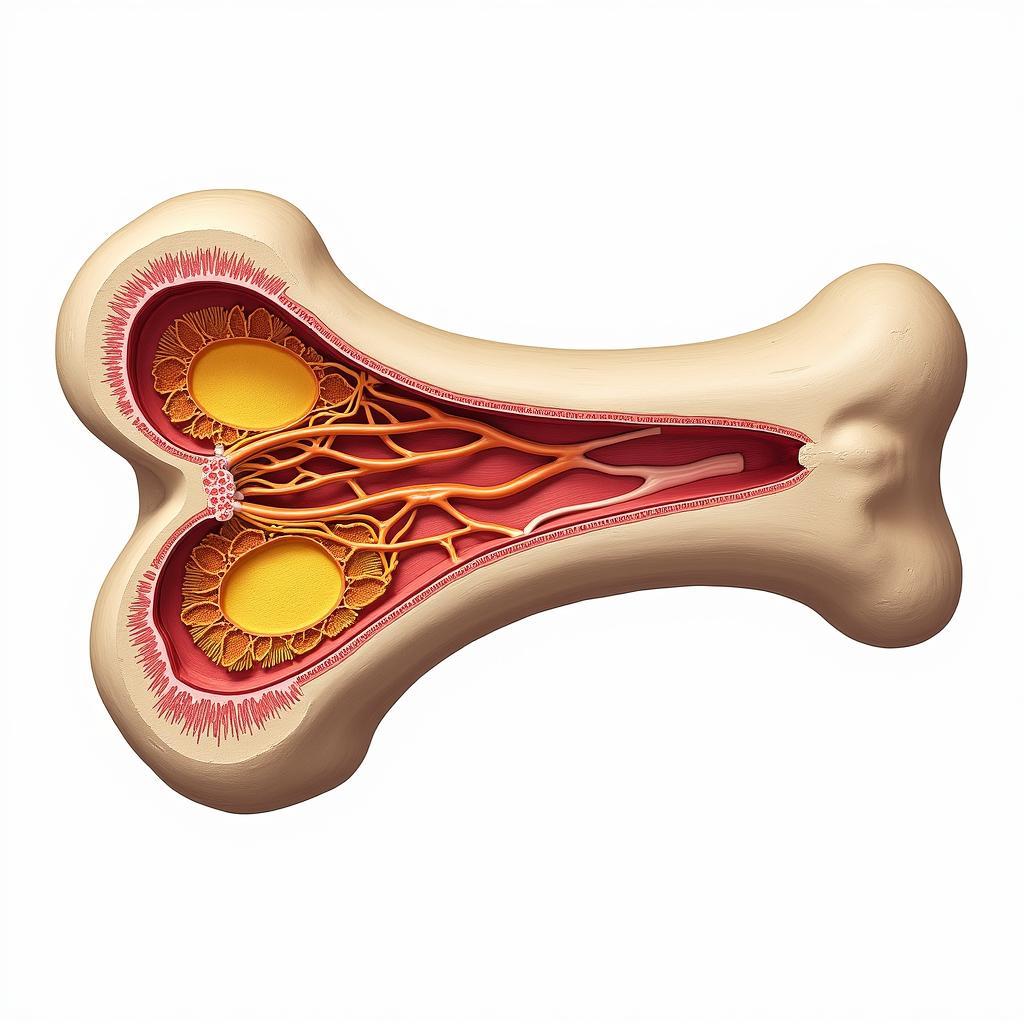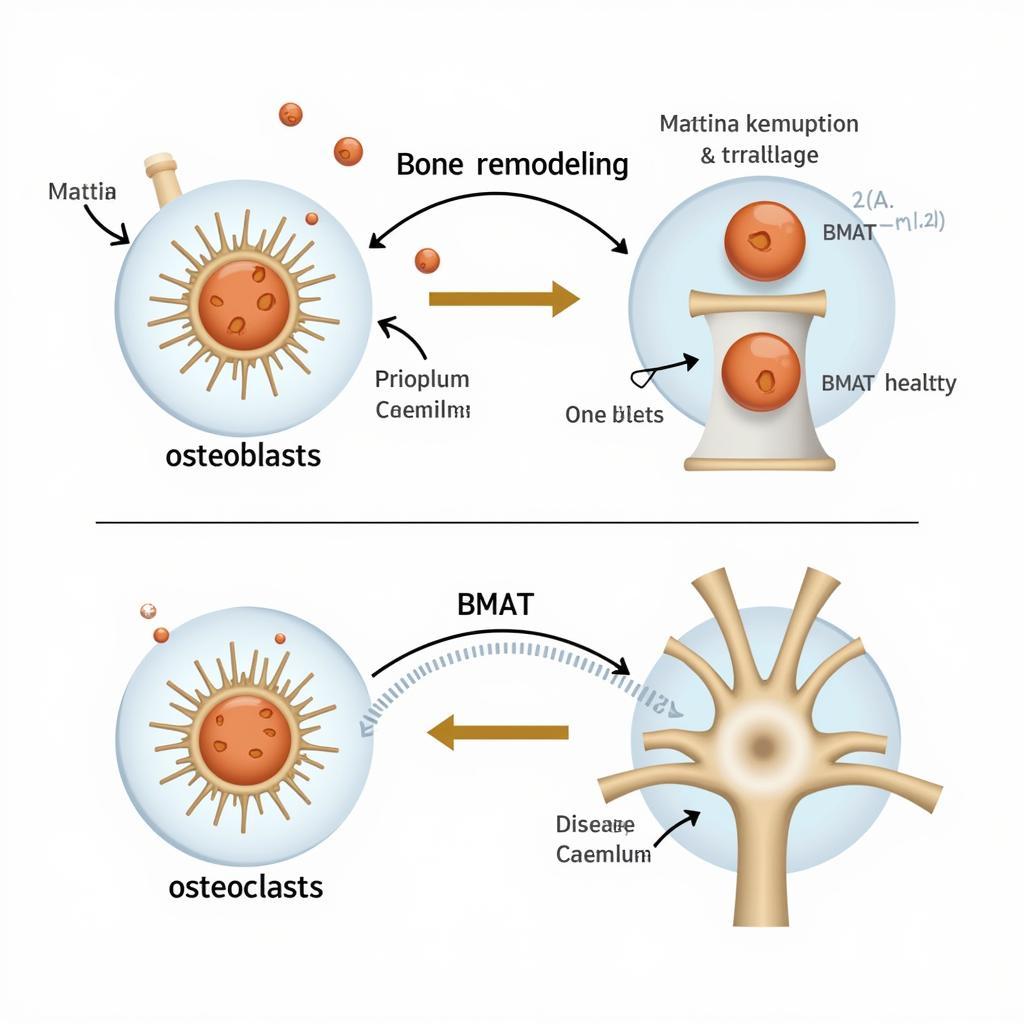The intricate world within our bones holds a fascinating paradox: bone marrow adipose tissue (BMAT). Often overlooked, BMAT plays a crucial role in our overall health, impacting bone density, metabolism, and even our immune response. This article delves into the multifaceted nature of Bone Marrow Adipose Society, exploring its functions, its implications on various health conditions, and its potential as a therapeutic target.
Unveiling the Hidden World of Bone Marrow Adipose Tissue
While most people associate bone marrow with blood cell production, it also houses a unique type of fat known as bone marrow adipose tissue (BMAT). Unlike white adipose tissue (WAT), the fat we typically think of, BMAT exhibits distinct characteristics and functions.
 Bone Marrow Structure
Bone Marrow Structure
BMAT: More Than Just Fat
BMAT’s role extends far beyond simply storing energy. It acts as a dynamic endocrine organ, secreting various hormones and signaling molecules that influence bone remodeling, energy balance, and inflammation. Studies suggest that BMAT may play a role in:
- Regulating Bone Health: BMAT influences bone formation and resorption, the processes that maintain bone strength and integrity.
- Modulating Metabolism: BMAT interacts with other organs like the liver and pancreas, impacting glucose metabolism and insulin sensitivity.
- Influencing Immune Response: BMAT can release inflammatory mediators, potentially affecting immune responses in both health and disease.
The Two Faces of BMAT: Beneficial and Detrimental
While BMAT serves essential functions, its accumulation can sometimes be detrimental. Excessive BMAT is linked to:
- Osteoporosis and Bone Fractures: Increased BMAT can disrupt the balance of bone formation and resorption, leading to weaker bones and a higher risk of fractures.
- Metabolic Disorders: Elevated BMAT is associated with insulin resistance, type 2 diabetes, and other metabolic diseases.
- Cancer Progression: Research suggests a potential link between BMAT and the progression of certain cancers, although more research is needed.
 BMAT and Bone Health
BMAT and Bone Health
The Future of BMAT Research: Targeting for Therapeutic Interventions
Understanding the complexities of BMAT holds immense promise for developing novel therapies for various conditions. Researchers are exploring ways to:
- Reduce Excessive BMAT: Developing drugs that specifically target and reduce BMAT accumulation could potentially improve bone health and metabolic outcomes.
- Manipulate BMAT for Regeneration: Harnessing the regenerative potential of BMAT could lead to innovative therapies for bone and tissue repair.
Living in Harmony: Maintaining a Healthy BMAT Balance
While research continues to unravel the full scope of BMAT’s influence, maintaining a healthy lifestyle can help support a balanced bone marrow environment. Here are some key factors to consider:
- Regular Exercise: Weight-bearing exercises and activities that put stress on bones can promote bone health and potentially regulate BMAT levels.
- Balanced Diet: A nutrient-rich diet, particularly one rich in calcium, vitamin D, and protein, is crucial for both bone and metabolic health.
- Healthy Weight Management: Maintaining a healthy weight can positively impact bone density and reduce the risk of metabolic disorders.
 Lifestyle and BMAT
Lifestyle and BMAT
The intricate relationship between bone marrow adipose tissue and our overall health is an evolving field of study. By understanding the vital role BMAT plays, we can make informed choices to support a balanced bone marrow environment and contribute to a healthier future.
Frequently Asked Questions about Bone Marrow Adipose Tissue (BMAT)
1. Can I get my BMAT levels checked?
Currently, routine clinical tests for measuring BMAT levels are not widely available. However, research is ongoing to develop more accessible and accurate methods for assessing BMAT in living individuals.
2. What are the long-term consequences of having too much or too little BMAT?
Excessive BMAT accumulation is linked to an increased risk of osteoporosis, metabolic disorders, and certain cancers. Conversely, very low BMAT levels have been associated with conditions like anorexia and chronic diseases. Maintaining a healthy balance is key.
3. Are there any specific foods that can help regulate BMAT levels?
While no specific foods directly target BMAT, a balanced diet rich in calcium, vitamin D, protein, and antioxidants supports overall bone and metabolic health, which indirectly influences BMAT.
4. Can lifestyle changes alone effectively manage BMAT levels?
Lifestyle modifications like regular exercise, a balanced diet, and maintaining a healthy weight can positively impact bone and metabolic health, which are closely linked to BMAT regulation. However, more research is needed to determine the direct impact of lifestyle interventions on BMAT levels.
5. What are the latest developments in BMAT research?
Scientists are actively investigating the potential of targeting BMAT for therapeutic interventions. This includes developing drugs to reduce excessive BMAT accumulation, exploring its role in cancer progression, and harnessing its regenerative potential for bone and tissue repair.
Need assistance? Please contact us:
Phone Number: 02043854663
Email: [email protected]
Address: Khu 34, Bac Giang, 260000, Vietnam.
Our customer support team is available 24/7 to assist you.